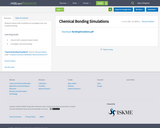
Students interact with simulations to investigate ionic and covalent bonding.
- Subject:
- Chemistry
- Physical Science
- Material Type:
- Homework/Assignment
- Date Added:
- 12/12/2018

Students interact with simulations to investigate ionic and covalent bonding.
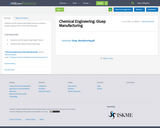
Students use the engineering design process to prepare a sample of gluep that can best meet their goal.

Chemistry 1A, Fall 2012. This course covers the stoichiometry of chemical reactions, quantum mechanical description of atoms, the elements and periodic table, chemical bonding, real and ideal gases, thermochemistry, introduction to thermodynamics and equilibrium, acid-base and solubility equilibria, introduction to oxidation-reduction reactions, introduction to chemical kinetics.
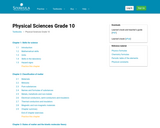
This is a comprehensive science textbook for Grade 10. You can download or read it on-line on your mobile phone, computer or iPad. Every chapter comes with video lessons and explanations which help bring the ideas and concepts to life. Summary presentations at the end of every chapter offer an overview of the content covered, with key points highlighted for easy revision. Topics covered are: skills for science, classification of matter, states of matter, kinetic molecular theory, the atom, the periodic table, chemical bonding, transverse pulses, transverse waves, longitudinal waves, sound, electromagnetic radiation, particles, compounds, physical and chemical change, representing chemical change, magnetism, electrostatics, electric circuits, reactions in aqueous solution, quantitive aspects of chemical change, vectors and scalars, motion in one direction, mechanical energy, the hydrosphere. This book is based upon the original Free High School Science Text series.
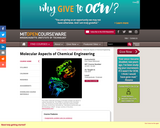
This class covers molecular-level engineering and analysis of chemical processes. Use of chemical bonding, reactivity, and other key concepts in the design and tailoring of organic systems are discussed. Specific class topics include application and development of structure-property relationships, and descriptions of the chemical forces and structural factors that govern supramolecular and interfacial phenomena for molecular and polymeric systems.
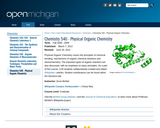
Chemistry 540 - Physical Organic Chemistry covers the principles of chemical bonding, mechanisms of organic chemical reactions and stereochemistry. The important types of organic reactions are also discussed, with an emphasis on basic principles. As a part of this course, U-M students collaboratively created and editedWikipedia÷articles. Student contributions can be found below, within the "Wikipedia Articles" section.
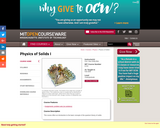
" This course offers an introduction to the basic concepts of the quantum theory of solids."
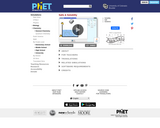
Add different salts to water, then watch them dissolve and achieve a dynamic equilibrium with solid precipitate. Compare the number of ions in solution for highly soluble NaCl to other slightly soluble salts. Relate the charges on ions to the number of ions in the formula of a salt. Calculate Ksp values.